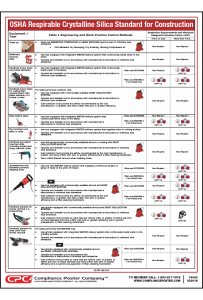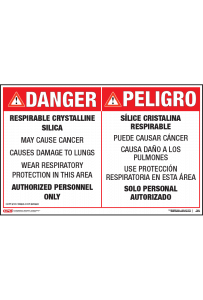 Two years ago, the federal Occupational Safety and Health Administration (OSHA) announced its final rule requiring employers to limit employees’ occupational exposure to respirable crystalline silica. The rule establishes two separate standards – one for the construction industry and one for general industry and maritime operations. The most controversial feature of the rule is that the amount of silica dust to which workers may be exposed to is half of what it was previously. It means that businesses are required to implement respirable crystalline silica exposure testing and control measures at much lower levels of exposure and comply with a number of other new requirements.
Two years ago, the federal Occupational Safety and Health Administration (OSHA) announced its final rule requiring employers to limit employees’ occupational exposure to respirable crystalline silica. The rule establishes two separate standards – one for the construction industry and one for general industry and maritime operations. The most controversial feature of the rule is that the amount of silica dust to which workers may be exposed to is half of what it was previously. It means that businesses are required to implement respirable crystalline silica exposure testing and control measures at much lower levels of exposure and comply with a number of other new requirements.
The Final Rule Gets Off to a Rocky Start
From the outset, OSHA’s respirable crystalline silica final rule was met with resistance. Shortly after the rule was announced in March of 2016, employer and construction industry groups and union organizations sued OSHA in six federal jurisdictions to prevent enforcement of the rule. These cases were consolidated into one lawsuit in the D.C. Circuit Court of Appeals. Employer groups argued that workers were adequately protected under existing silica standards. Unions argued that the rule didn’t go far enough to protect workers. In December of 2017, the court decided in favor of OSHA, upholding the new silica standard.
While the lawsuit was still pending, OSHA announced that it would delay enforcement of the construction standard from its original enforcement date of June 23, 2017 until September 23, 2017. Also, for the first 30 days OSHA offered employers compliance assistance in lieu of enforcement. Full enforcement of the construction industry standard began on October 23, 2017. Enforcement of the general industry and maritime standard begins on June 23, 2018. Fracking operations in the oil and gas industry have until June 23, 2021 to implement exposure controls.
What is Crystalline Silica?
Crystalline silica is a common mineral found in materials such as sand, stone, concrete, brick and mortar. Workers can inhale tiny, respirable particles of crystalline silica – typically at least 100 times smaller than ordinary sand – while performing activities such as abrasive sand blasting; sawing brick or concrete; sanding or drilling into concrete; grinding mortar; and manufacturing glass, pottery, ceramic, brick, concrete, asphalt roofing, jewelry, stone, dental, porcelain, or structural clay products. The particles can enter workers’ lungs and cause silicosis, an incurable and sometimes fatal disease. Exposure to crystalline silica dust also increases the risk of lung cancer, kidney disease, and chronic obstructive pulmonary disease (COPD).
What does the Final Rule Require?
The final rule imposes a number of requirements on businesses to limit worker exposures to respirable silica, but the main focus of the rule is the lower permissible exposure limit (PEL) for respirable silica. The new PEL for airborne crystalline silica is 50 micrograms per cubic meter of air (50 μg/m3) averaged during an 8-hour work day. The previous standard for general industry was 100 μg/m3, and 250 μg/m3 for construction and maritime industries.
To comply with the new PEL, construction employers can either use the control methods identified in Table 1 of the final rule or measure workers’ exposure to silica dust and decide which dust control methods work best for their workplaces. Table 1 lists 18 common construction tasks and equipment and engineering and work practice exposure control methods. This includes water delivery systems, HEPA-filtered vacuuming, and workers’ use of respiratory protection. General industry and maritime employers may also use Table 1 to comply with the PEL standard. Employers choosing not to follow Table 1 are required to measure respirable crystalline silica by testing air samples when exposure is at or expected to be above the established action level of 25 μg/m3.
In addition to implementing exposure controls, all employers are required to:
- Limit access to areas where workers could be exposed above the PEL;
- Develop written control plans;
- Restrict housekeeping practices that expose workers to silica;
- Offer medical exams every three years to workers who are required to wear respirators;
- Train workers on the types of activities that result in silica exposure and ways to limit exposure;
- Keep records of workers’ silica exposure and medical exams; and
- Construction employers must designate a competent person to implement the written control plan.
What are the Training Requirements?
OSHA’s training requirements under the new rule are performance-based. During an OSHA investigation, employees should be able to demonstrate knowledge and understanding of the following topics:
- Health hazards associated with exposure to crystalline silica
- Specific tasks that can result in exposure
- Specific measures the employer has taken to protect employees from exposure, including engineering controls, work practices, and respirators to be used
- Contents of the standard pertinent to the industry
- The purpose of the medical surveillance program
One of the best ways employers can support training and facilitate worker compliance with control measures is by posting Compliance Poster Company’s OSHA Respirable Crystalline Silica Standard for Construction Poster. The poster identifies Table 1’s tasks and equipment and the appropriate engineering and work practice control methods. By posting a visual reference tool in the workplace, workers can easily determine the exposure controls for the task they are performing.
 Posting Warning Signs Required
Posting Warning Signs Required
General industry employers must post specific danger signs at all entrances to areas where concentrations of respirable crystalline silica are, or may exceed, the PEL. Construction employers must include as part of their written control plan a description of how the employer restricts access to work areas to limit the number of employees exposed to silica dust. Compliance Poster Company’s Respirable Crystalline Silica Danger Sign complies with both the general industry and construction industry requirements to control unnecessary employee exposure.
All employers whose operations expose workers to respirable crystalline silica are encouraged to post instructive control measures and entry warning signs to ensure compliance with OSHA’s respirable crystalline silica standards.

